Resistance Band Exercises for Speed
Focusing on sprint-based training or speed-based training and we’re talking about band work, we need to think about the musculature action we are looking to occur. We want to see the speed of the musculature action, so there will be movements that are extremely rapid. We want extremely rapid movements because we want to train the nervous system to fire extremely quickly so it recruits really, really well to understand how to apply the skills on to the field, track, or whatever it is being trained for.

The other aspect that we want to look for is the unilateral or bilateral work where there is an isometric musculature action, which in turn can improve the overall dynamic trunk control. It will also help improve our technique.
So we have to think when we use bands there is going to be more tension as the band lengthens and elongates. The greater tension will lead to superior coordination and a mind-muscle connection which will help lead to a greater transfer to improving technique; we are also looking for a high rate of musculature action that will lead to overall speed. We have to think about these two key concepts as we go through these exercises.
1. Banded Sprinter Start
This exercise can be utilized by football players, soccer players, lacrosse players, and sprinters, hence the name. We use PowerLastic bands because they’re the best.
To perform the movement we want to anchor the PowerLastic band to an immovable object. We want to put the one banded handgrip through the other banded handgrip to lengthen the band while still allowing for tremendous amounts of tension. In front of the body, we will have a box stationed. The box may need to be moved around to be put in the ideal position.

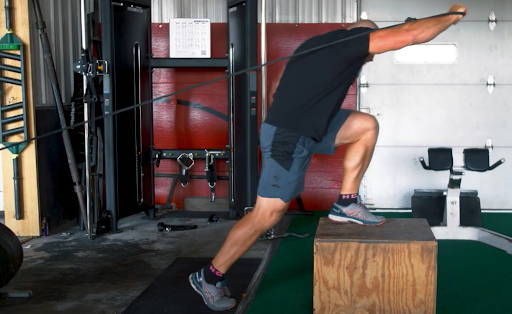
If the band is in the right arm, we want to see the left leg get up on the box for contralateral work. Essentially the arm extending, the opposite leg is driving up to the box. This movement is FAST and EXPLOSIVE! Ideally, we want to see a connection from the plantar flexion, into knee flexion, into hip extension, all the way into where the band is taut at the top. This helps spark up the trunk and assists the athlete in becoming quicker.
This movement can be performed with an auditory cue to help athletes learn how to react a little faster.
Do five to six sets for three to four reps to each side once a week.

2. Banded Single-Leg Sprint
Using a PowerLastic strength band, we again want the band attached to an immovable object with the band wrapped around the ankle. We want the leg that will be raised into a hiplock to have the band wrapped around the ankle. The other leg will be planted as if the grounding force at high speeds. When we come through, we want to hold.
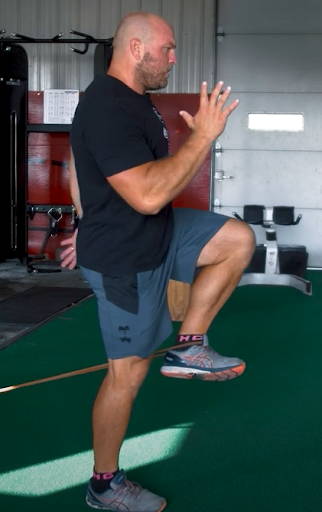
We want to focus on having an upright posture. We want to see a squeeze from the hips into the lower abs. This is a big focus because if we can control that position we can hold our trunk better at higher speeds to run quicker and handle all of the energy through the trunk.
The cool thing about doing this movement is that when the hip is squeezed into the trunk, the hamstring on the other leg will be firing holding the grounded position. This is a movement that is a really great tool to teach sprinting mechanics for running at top-end speed, feeling the hip flexion into the abs while feeling the hamstring on the downside.
Do five to six sets of three to four reps on each leg two or three times a week as a drill to improve technique. Play around with the isometric action to lead to strength gains as well.
3. Banded Skater Into Snatch Hiplock
This is a unilateral exercise that transfers well to a starting position for any athlete in any sport. The key is the movement targets the muscles from a unilateral perspective that then transfers to a rapid reaction once the knee touches the ground, triggering the body to fire into a hiplock with a snatch position.
This movement will be a little bit more posterior chain while still targeting the quads. This makes the movement very unique.
We want flexion in the down knee that is tracking back to the ground. On the other leg, we will squat with a controlled eccentric while holding the band, which is wrapped around an immovable object, in each hand. As the knee touches, we will explode up into a hiplock with a snatch position
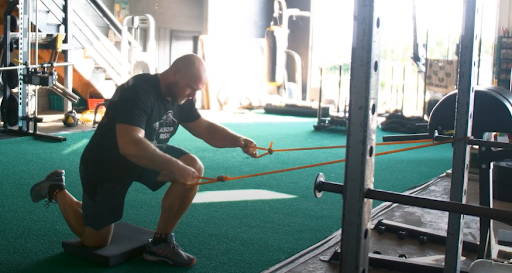
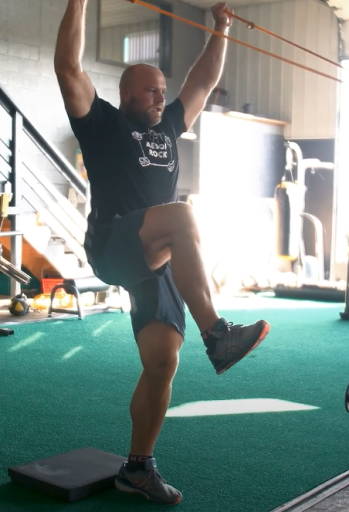
One of the unique things is that the band may climb up on the squat rack. Having something with a notch is okay. Make sure to hit the hiplock to improve the body’s dynamic trunk control. The reaction really develops the speed. Now what happens with athletes who are dominant to one side, we will see the athlete start falling all over the place when they get to the weaker side. We recommend training the weak side first.
Perform two to three sets of three to four reps on each leg of this movement. Do this movement once or twice a week to improve mobility, strength, and speed of contraction.
4. Banded Quarter Squat Jumps
Remember back to the intro when we talked about focusing on the speed of the muscular action and technique? Thus far all the movements we have introduced have been a little bit of both. This movement, banded quarter squat jumps, is just going to be a straight-up muscular action movement.
We think it is important to teach athletes how to absorb more energy, explode very rapidly, and do again just as fast. This will help improve an athlete’s vertical jump, first step, and quicken their reaction time.

To do this movement, we want to put the handles of the PowerLastic band around the feet and wrap the slack around the neck. We then want to get into a quarter squat. The quarter squat will cause a bit of tension to pull out of the band. We will then jump, extending up, putting tension back into the band. Then as we land, we’re going to come back into the quarter squat and react a little bit faster into a series of jumps.
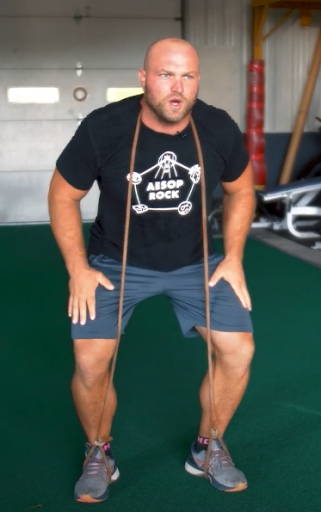
This is a bilateral movement that can be used to potentiate other exercises. It is also a very easy exercise that can be performed anywhere. It will train the nervous system to fire extremely fast.
Do this movement for two to three sets of five to ten reps. We recommend doing it once a week, maybe twice, but make sure there are three days between performing the movement.
Recap
Every sport demands fast, explosive athletes. Being fast gives advantages in all manners of athletic competition. Thankfully utilizing bands, like the PowerLastics, to create tension in exercises are a great manner to train for speed. Not only do the bands in conjunction with the four exercises described above make athletes faster, but they also contribute to improving technique. So after purchasing a PowerLastic band, go ahead and give these banded speed exercises a go and let us know which one was the hardest to perform.
DANE MILLER
Dane Miller is the owner and founder of Garage Strength Sports Performance. He works with a select handful of clients on building comprehensive programs for fitness and nutrition. Several times a year he leads a workshop for coaches, trainers, and fitness enthusiasts.


